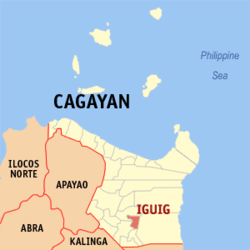Iguig
| Iguig | ||
|---|---|---|
| Municipality | ||
| Municipality of Iguig | ||
 St. James the Apostle Parish in Calvary Hills | ||
| ||
| Nickname(s): Pottery Center of Cagayan | ||
 Map of Cagayan with Iguig highlighted | ||
.svg.png) Iguig Location within the Philippines | ||
| Coordinates: 17°45′N 121°44′E / 17.75°N 121.73°ECoordinates: 17°45′N 121°44′E / 17.75°N 121.73°E | ||
| Country |
| |
| Region | Cagayan Valley (Region II) | |
| Province | Cagayan | |
| District | 3rd District | |
| Founded | December 28, 1607 | |
| Barangays | 23 (see Barangays) | |
| Government [1] | ||
| • Type | Sangguniang Bayan | |
| • Mayor | Ferdinand B. Trinidad | |
| • Electorate | 14,991 voters (2016) | |
| Area [2] | ||
| • Total | 108.10 km2 (41.74 sq mi) | |
| Population (2015 census)[3] | ||
| • Total | 27,862 | |
| • Density | 260/km2 (670/sq mi) | |
| Time zone | UTC+8 (PST) | |
| ZIP code | 3504 | |
| PSGC | 021515000 | |
| IDD : area code | +63 (0)78 | |
| Climate type | Tropical monsoon climate | |
| Income class | 4th municipal income class | |
| Revenue (₱) | 82,498,437.94 (2016) | |
| Native languages |
Ibanag Ilocano Tagalog | |
| Website |
www | |
Iguig, (Ibanag: Ili nat Iguig; Ilokano: Ili ti Iguig; Filipino: Bayan ng Iguig), officially the Municipality of Iguig, is a 4th class municipality in the province of Cagayan, Philippines. According to the 2015 census, it has a population of 27,862 people.[3]
It is best known as the hometown of Dado Banatao, a well-known Filipino-American software engineer credited for having developed the first 10-Mbit Ethernet CMOS with silicon coupler data-link control and transreceiver chip.[4]
Barangays
Iguig is politically subdivided into 23 barangays.
- Ajat (Poblacion)
- Atulu
- Baculud
- Bayo
- Campo
- Dumpao
- Gammad
- Garab
- Malabbac
- Manaoag (Aquiliquilao)
- Minanga Norte
- Minanga Sur
- Nattanzan (Poblacion)
- Redondo
- Salamague
- San Esteban (Capitan)
- San Isidro (Ugac West)
- San Lorenzo
- San Vicente (Ugac East)
- Santa Barbara
- Santa Rosa
- Santa Teresa (Gammad Sur)
- Santiago
Demographics
| Population census of Iguig | ||
|---|---|---|
| Year | Pop. | ±% p.a. |
| 1903 | 3,800 | — |
| 1918 | 5,413 | +2.39% |
| 1939 | 8,205 | +2.00% |
| 1948 | 8,115 | −0.12% |
| 1960 | 11,263 | +2.77% |
| 1970 | 13,684 | +1.96% |
| 1975 | 14,286 | +0.87% |
| 1980 | 15,760 | +1.98% |
| 1990 | 18,598 | +1.67% |
| 1995 | 19,100 | +0.50% |
| 2000 | 21,858 | +2.93% |
| 2007 | 26,096 | +2.47% |
| 2010 | 25,559 | −0.75% |
| 2015 | 27,862 | +1.66% |
| Source: Philippine Statistics Authority[3][5][6][7] | ||
In the 2015 census, the population of Iguig was 27,862 people,[3] with a density of 260 inhabitants per square kilometre or 670 inhabitants per square mile.
References
- ↑ "Municipality". Quezon City, Philippines: Department of the Interior and Local Government. Retrieved 31 May 2013.
- ↑ "Province: Cagayan". PSGC Interactive. Quezon City, Philippines: Philippine Statistics Authority. Retrieved 12 November 2016.
- 1 2 3 4 Census of Population (2015). "Region II (Cagayan Valley)". Total Population by Province, City, Municipality and Barangay. PSA. Retrieved 20 June 2016.
- ↑ http://www.phildev.org/ourteam/
- ↑ Census of Population and Housing (2010). "Region II (Cagayan Valley)". Total Population by Province, City, Municipality and Barangay. NSO. Retrieved 29 June 2016.
- ↑ Censuses of Population (1903–2007). "Region II (Cagayan Valley)". Table 1. Population Enumerated in Various Censuses by Province/Highly Urbanized City: 1903 to 2007. NSO.
- ↑ "Province of Cagayan". Municipality Population Data. Local Water Utilities Administration Research Division. Retrieved 17 December 2016.
External links

- Philippine Standard Geographic Code
- Philippine Census Information
This article is issued from
Wikipedia.
The text is licensed under Creative Commons - Attribution - Sharealike.
Additional terms may apply for the media files.
